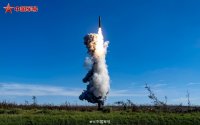I disagree. Modern ICBMs accelerate very very fast. It has been a desired feature for survivability and decreased time to target since the 1960s. I once read that they accelerate to their top speed and start to deploy their warheads within 2 minutes.I followed the post and all its pictures. I got the feeling of this launch looks more like a boost-glider than a ballistic ICBM because the 3rd stage separated less than 850km from launch point giving the unpowered flight of 11000km, that doesn't look ballistic.
You are using an out of date browser. It may not display this or other websites correctly.
You should upgrade or use an alternative browser.
You should upgrade or use an alternative browser.
China ICBM/SLBM, nuclear arms thread
- Thread starter Blitzo
- Start date
Ah, yes. I first meant DF-4 but I typed DF-41 'cos I found that DF-4 have been long retired and forget that DF-41 was mobile launched...For record's purpose, The NOTAM info:
China notified the Philippines and France in advance as the NOTAM was issued by Manila FIR and Tahiti FIR.
DF-41 is not silo launched missile. The missile is highly likely to be launched from or near WSLC so it can be anything, even starship.
No. Relevant countries should be those countries that have the ablility to inflict a counterattack when they get a nuclear attack alert.relevant countries are Philippines and France because of the drop zones of stages are near Philippines and target zone near French adminstrated islands.
I don't think it matters much. Faster acceleration makes the objects reach the same separation altitude and down range in shorter time. If the acceleration is faster, the stages reaches higher speed at a relatively lower altitudes or shorter section of the ballistic arch, but after separation the spent booster sections will continue at higher speed in the same trajectories and land at the simliar spot as in case of slower acceleration because the arch does not change for the same range.I disagree. Modern ICBMs accelerate very very fast. It has been a desired feature for survivability and decreased time to target since the 1960s. I once read that they accelerate to their top speed and start to deploy their warheads within 2 minutes.
I said not much because I know it matters a bit, faster acceleration means higher speed in a shorter time span. Air resistance increase faster than increase of speed, so the free travel of 1st stage is reduced, its drop zone would be closer, but the effect on 2nd and 3rd stage is much less to zero because they separate near or out in a vacumm.
Overall, in this test, the 3rd stage landed at 14.4% of the total range, it is too close to launch point that I can imagine to fit a typical ballistic trajectory.
There must be some pretty powerful "water" in those missiles!
Probably used enough rocket fuel to boil a billion hot pots. What a repressive government that doesn’t think of its people.
See those fragments around the plume? Hot pots.Probably used enough rocket fuel to boil a billion hot pots. What a repressive government that doesn’t think of its people.
I have a few theories for the purpose of this test.
1. Verifying operational readiness. Draw a random missile out from the inventory, launch it and see if it performs well.
2. R&D of new missile.
3. R&D of new platform, like TEL or ships
I think 1 is the most likely.
1. Verifying operational readiness. Draw a random missile out from the inventory, launch it and see if it performs well.
2. R&D of new missile.
3. R&D of new platform, like TEL or ships
I think 1 is the most likely.
I have a few theories for the purpose of this test.
1. Verifying operational readiness. Draw a random missile out from the inventory, launch it and see if it performs well.
2. R&D of new missile.
3. R&D of new platform, like TEL or ships
I think 1 is the most likely.
It is a DF-31. Not really a new missile.
The reason why China developed advanced weapons and upshift military fees is that China makes sure that China will have the ability to make US also love peace.
No cable van or any other supporting vehicle in the sight, a good start to demonstrate survivabilityView attachment 136436
It looks like it was actually launched by TEL parked in a field? Quite good simulation of actual combat conditions? The damage from the recent super typhoon Yagi on the plants are even visible in this photo.
I think it is nothing more than a regular test every month except the impact zone.I have a few theories for the purpose of this test.
1. Verifying operational readiness. Draw a random missile out from the inventory, launch it and see if it performs well.
2. R&D of new missile.
3. R&D of new platform, like TEL or ships
I think 1 is the most likely.

